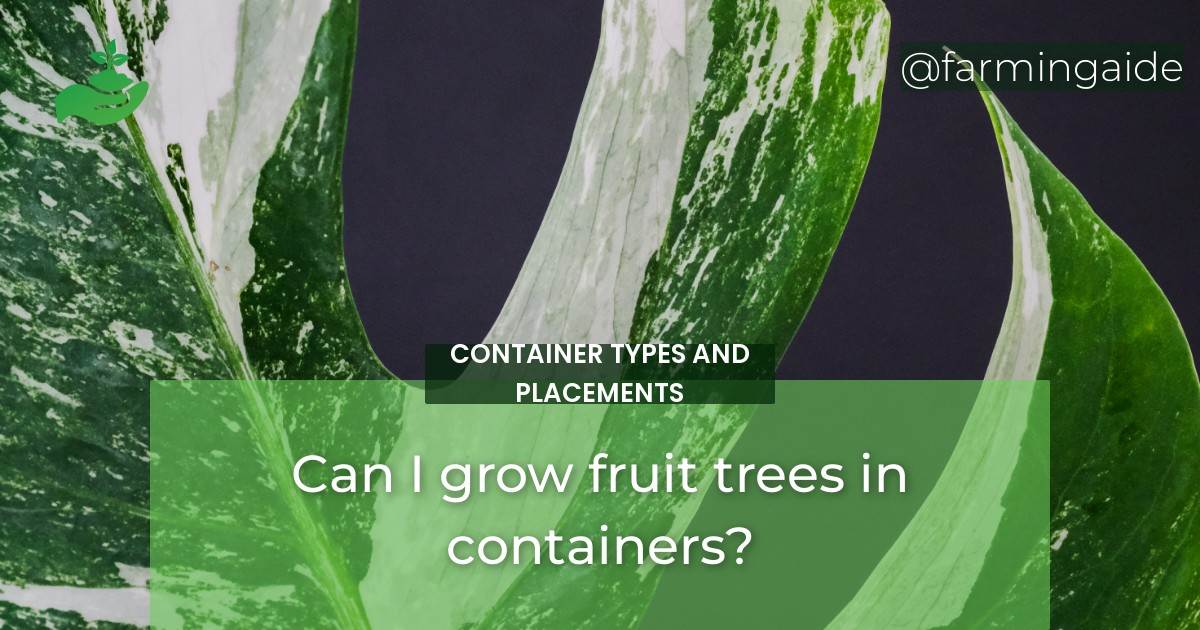Growing fruit trees in containers is a great way to enjoy fresh fruit even when you don’t have space for a traditional orchard. With the right container, soil, fertilizer, and care, you can grow a variety of fruit trees on a patio, balcony, or even indoors. However, there are important factors to consider when choosing container types and placements to ensure successful growth and harvest.
Container Types and Placements
Choosing the Right Container
When choosing a container for fruit trees, consider the following factors:
- The size and type of fruit tree
- The material and drainage of the container
- The location and climate of the growing area
Types of containers suitable for growing fruit trees include:
- Plastic or resin pots
- Terra cotta or clay pots
- Fabric or grow bags
- Wooden barrels or boxes
Placement of Containers
When choosing a location for fruit tree containers, consider the following factors:
- The amount of sunlight, wind, and shade in the area
- The temperature and humidity levels
- The soil and drainage of the growing area
Best locations for growing fruit trees in containers include:
- A sunny, sheltered area with good drainage
- A location with consistent temperatures and humidity levels
- A spot with easy access to water and fertilizer
Best Fruit Trees for Container Growing
Dwarf Varieties
Dwarf fruit trees are ideal for container growing because they are smaller in size and produce fruit earlier than standard-sized trees. Benefits of dwarf fruit trees include:
- Easy to move and maintain
- Fast-growing and fruit-producing
- Require less space and pruning
Best dwarf fruit tree varieties for containers include:
- Apple
- Cherry
- Citrus (lemon, lime, orange)
- Peach
- Pear
Other Suitable Fruit Trees
Other fruit trees that can grow in containers include:
- Fig
- Grape
- Kiwi
- Olive
- Pomegranate
Factors to consider when choosing fruit tree varieties for container growing include:
- The size and root system of the tree
- The cold hardiness and disease resistance of the tree
- The pollination requirements of the tree
ALSO READ
Growing Fruit Trees in Containers
Soil and Fertilizer
Best soil types for container growing include:
- High-quality potting soil
- Compost or organic matter
- Perlite or vermiculite for drainage
Fertilizer requirements for fruit trees in containers include:
- A slow-release fertilizer applied in spring and summer
- An organic fertilizer applied every four to six weeks
- A balanced fertilizer with a ratio of 10-10-10 or 14-14-14
Watering and Pruning
Best watering practices for fruit trees in containers include:
- Watering deeply and regularly to keep soil moist but not waterlogged
- Allowing soil to dry slightly between waterings
- Adding mulch or stones around the base of the tree to retain moisture
Pruning techniques for container-grown fruit trees include:
- Pruning in winter or early spring before new growth appears
- Removing dead or diseased branches
- Trimming back overly long or crossing branches
Pest and Disease Control
Common pests and diseases of fruit trees in containers include:
- Aphids, spider mites, and other insects
- Fungal diseases such as powdery mildew or black spot
- Viral or bacterial diseases such as fire blight
Prevention and treatment of pests and diseases include:
- Regular monitoring and early detection
- Using natural or chemical pesticides and fungicides
- Sanitizing pruning tools and containers regularly
Harvesting Container-Grown Fruit Trees
Harvesting Techniques
Best practices for harvesting fruit from container-grown fruit trees include:
- Waiting until fruit is fully ripe and easily comes off the tree
- Using a sharp knife or pruning shears to remove fruit
- Harvesting in the morning when fruit is coolest and less likely to bruise
Factors to consider when harvesting fruit from containers include:
- The ripeness and quality of the fruit
- The time of year and weather conditions
- The size and health of the tree
ALSO READ
Conclusion
Growing fruit trees in containers is a rewarding and practical way to enjoy fresh fruit without a traditional orchard. By choosing the right container, soil, fertilizer, and care, you can successfully grow a variety of fruit trees on a patio, balcony, or indoors. With proper maintenance and harvesting, you can enjoy the taste and beauty of container-grown fruit trees for years to come.


